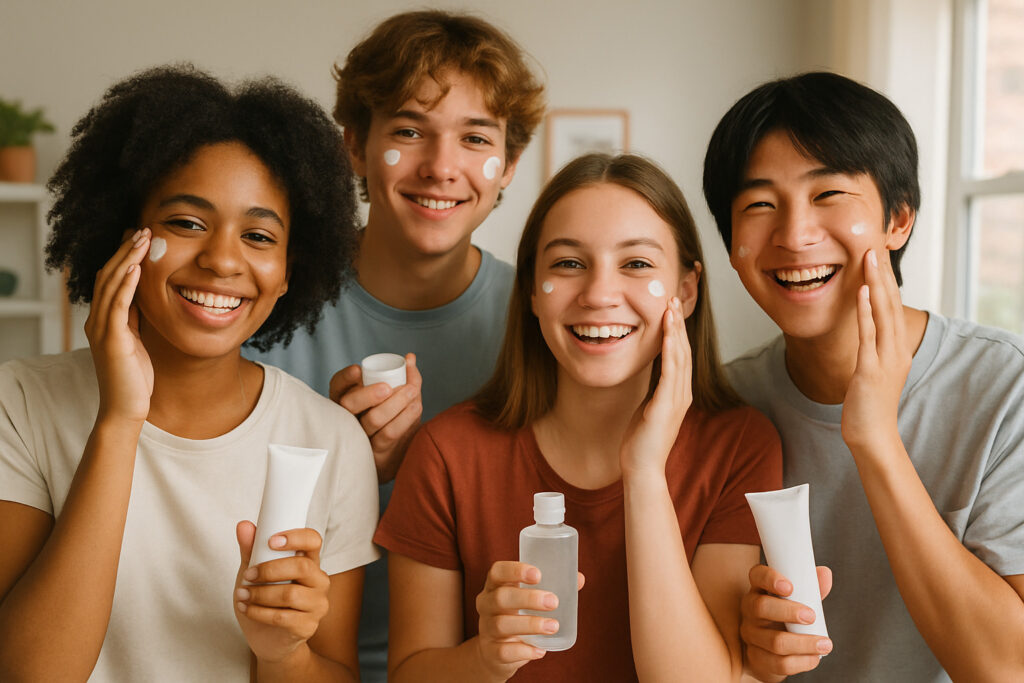Why Navigating Teen Beauty Feels So Overwhelming
Beauty tips for teens aren’t just about looking good – they’re about building confidence during one of the most transformative times in your life. Between hormonal changes, acne breakouts, and endless social media beauty standards, figuring out what actually works for your skin can feel impossible.
Essential Teen Beauty Basics:
– Cleanse twice daily with a gentle, non-comedogenic cleanser
– Moisturize morning and night to maintain skin barrier health
– Apply SPF 30+ sunscreen every day, even indoors
– Remove makeup completely before bed to prevent clogged pores
– Keep it simple – introduce one new product at a time
– See a dermatologist if over-the-counter treatments don’t work after 6-8 weeks
The truth is, effective teen skincare doesn’t require expensive products or complicated routines. Research shows that 85% of teens experience acne, and the most successful approaches focus on gentle consistency rather than harsh treatments.
This guide breaks down science-backed beauty tips that actually work for teen skin, from building a simple daily routine to understanding when professional help makes sense.
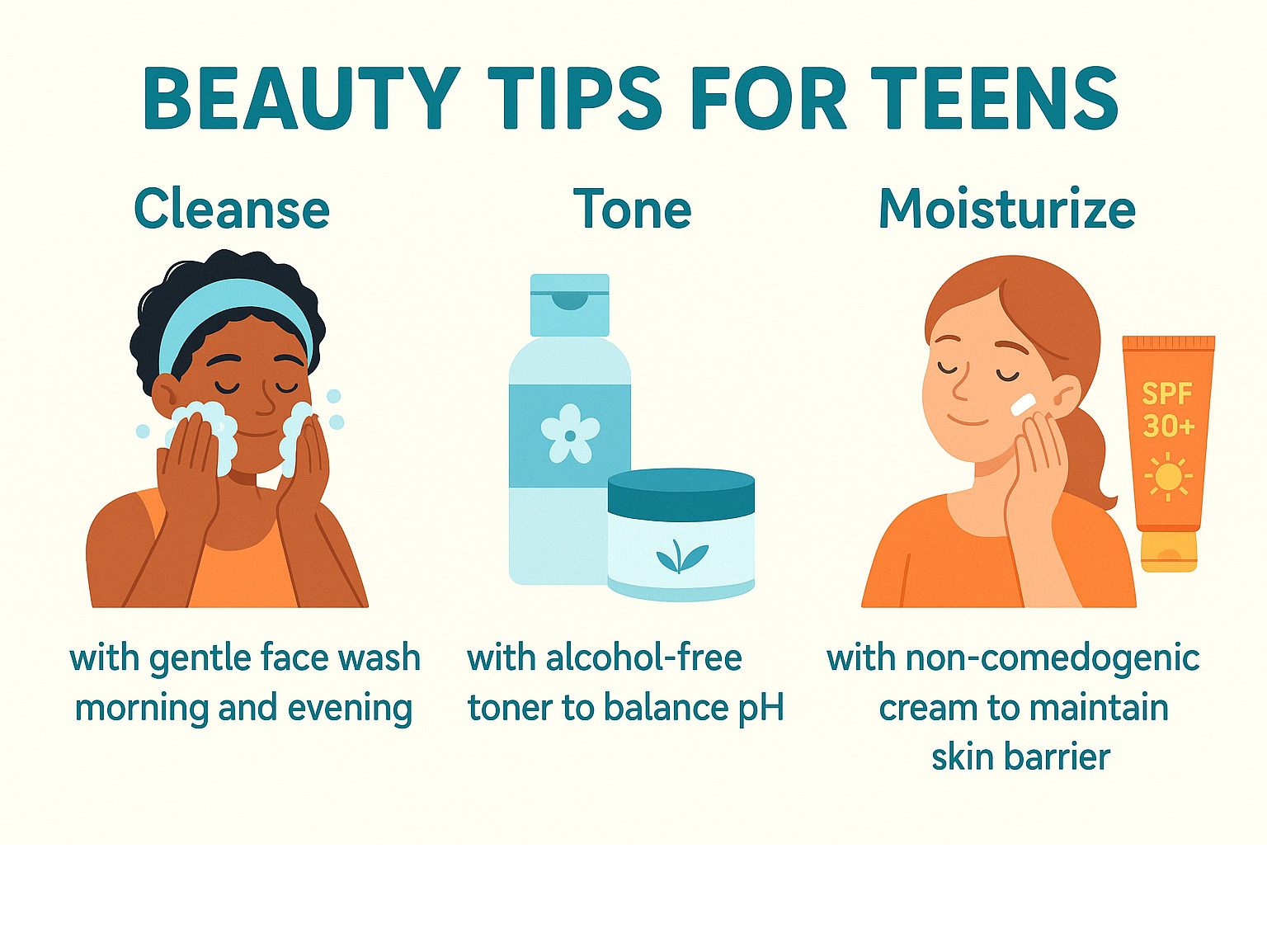
Beauty tips for teens definitions:
– Beauty and wellness trends
– DIY face masks
– Natural skincare tips
Top 10 Beauty Tips for Teens (Daily Routine Cheat Sheet)
Starting a skincare routine as a teen doesn’t have to feel complicated. Consistency beats complexity every single time. Your skin responds better to gentle, regular care than harsh treatments you might try when frustrated with breakouts.
The foundation starts with cleansing twice daily using a mild, non-comedogenic cleanser that won’t strip your skin. After cleansing, an alcohol-free toner can help balance pH, but don’t stress if you skip this step. Moisturizing damp skin locks in hydration better than waiting until completely dry.
The non-negotiable? Never skip sunscreen in the morning – SPF 30 or higher, every single day. Remove all makeup before bed, no matter how tired you feel. Change your pillowcase weekly to reduce bacteria buildup.
Introduce one product at a time and give it 4-6 weeks to show results. Avoid over-scrubbing – gentle circular motions are sufficient. Stay hydrated throughout the day. If over-the-counter treatments aren’t working after a few months, schedule a dermatologist visit.
Research shows that teens who develop acne are at higher risk for depression within the first year of diagnosis, making an effective routine crucial for both physical skin health and overall wellbeing.
Ready to build your routine? Check out our guide to Beauty Products for Teens for products specifically designed with younger skin in mind.
Morning Beauty Tips for Teens
Your morning routine should be quick, refreshing, and protective. Start with gentle cleansing using lukewarm water. If you have oily skin, toning with an alcohol-free formula can help, but dry or sensitive skin can skip this step.
Moisturizing comes next – apply to slightly damp skin to seal in hydration. Sun protection with broad-spectrum SPF 30+ is essential every morning. If you wear makeup, keep it minimal during the day with non-comedogenic formulas.
This routine should take 5-10 minutes. Try pairing it with brushing your teeth for easier habit formation.
Nighttime Beauty Tips for Teens
Nighttime is when your skin repairs itself. Double cleansing works well if you wear makeup – start with micellar water, then follow with regular cleanser. Remove all makeup completely, even when exhausted.
Apply any treatment products like benzoyl peroxide at night, starting with lower concentrations. Moisturize damp skin to maximize hydration. Aim for 7-8 hours of sleep – your skin literally repairs itself during deep sleep.
Change your pillowcase at least twice weekly, or daily if dealing with active acne.
Keep It Simple, Consistent, Safe
The biggest mistake teens make is trying harsh products to fix everything at once. Patch test new products on a small skin area for 7-10 days before full-face use. Introduce one product at a time over 4-6 weeks.
Listen to your skin – redness, burning, or excessive dryness mean you should scale back. Look for “non-comedogenic,” “fragrance-free,” and “dermatologist-tested” on labels.
Drugstore products often contain the same active ingredients as expensive alternatives. Check out Budget-Friendly Skincare Products for Teens for effective, affordable options.
Build Your Breakout Battle Plan
About 85% of teens experience breakouts, making acne one of the most common skin challenges during these years. During puberty, hormones increase oil production, and when that oil mixes with dead skin cells and bacteria, it creates clogged pores and breakouts.
The key is following a step-by-step approach: start with gentle over-the-counter treatments, then move to prescription options if needed after 6-8 weeks. Scientific research on diet & acne suggests high-sugar foods could be linked to breakouts, so cutting back on processed foods might help some teens.
Lifestyle factors matter too – stress can trigger breakouts, and washing sheets weekly prevents bacteria buildup.
For comprehensive guidance, check out Skincare for Acne-Prone Skin.
Step-by-Step Acne Toolkit
Start with basics during weeks 1-2: cleanse twice daily with mild cleanser, use oil-free moisturizer, and apply sunscreen every morning.
Week 3: introduce your first active ingredient – choose either benzoyl peroxide (start with 2.5%) or salicylic acid (2%), never both at once. Apply to clean, dry skin and follow with moisturizer.
The 4-6 week rule is crucial – most treatments need at least a month to show results. After 6-8 weeks, assess whether your routine is working or needs adjustment.
If over-the-counter treatments aren’t effective after 8 weeks, see a dermatologist. Don’t feel like you’ve failed – sometimes skin needs professional-strength treatments.
Important don’ts: avoid picking (pushes infection deeper), don’t over-wash (strips natural oils), and resist using multiple harsh products simultaneously.
Sensitive-Skin Strategy
Sensitive skin can still be clear skin with the right approach. Choose fragrance-free, hypoallergenic products and use lukewarm water for cleansing. Pat skin dry instead of rubbing.
For teens with eczema or other conditions, patch testing becomes even more important. Apply new products to small skin areas for 7-10 days before full-face use.
If you exercise regularly, synthetic workout clothes wick moisture better than cotton, reducing irritation during workouts.
Sunscreen & Sun-Smart Habits Every Teen Needs
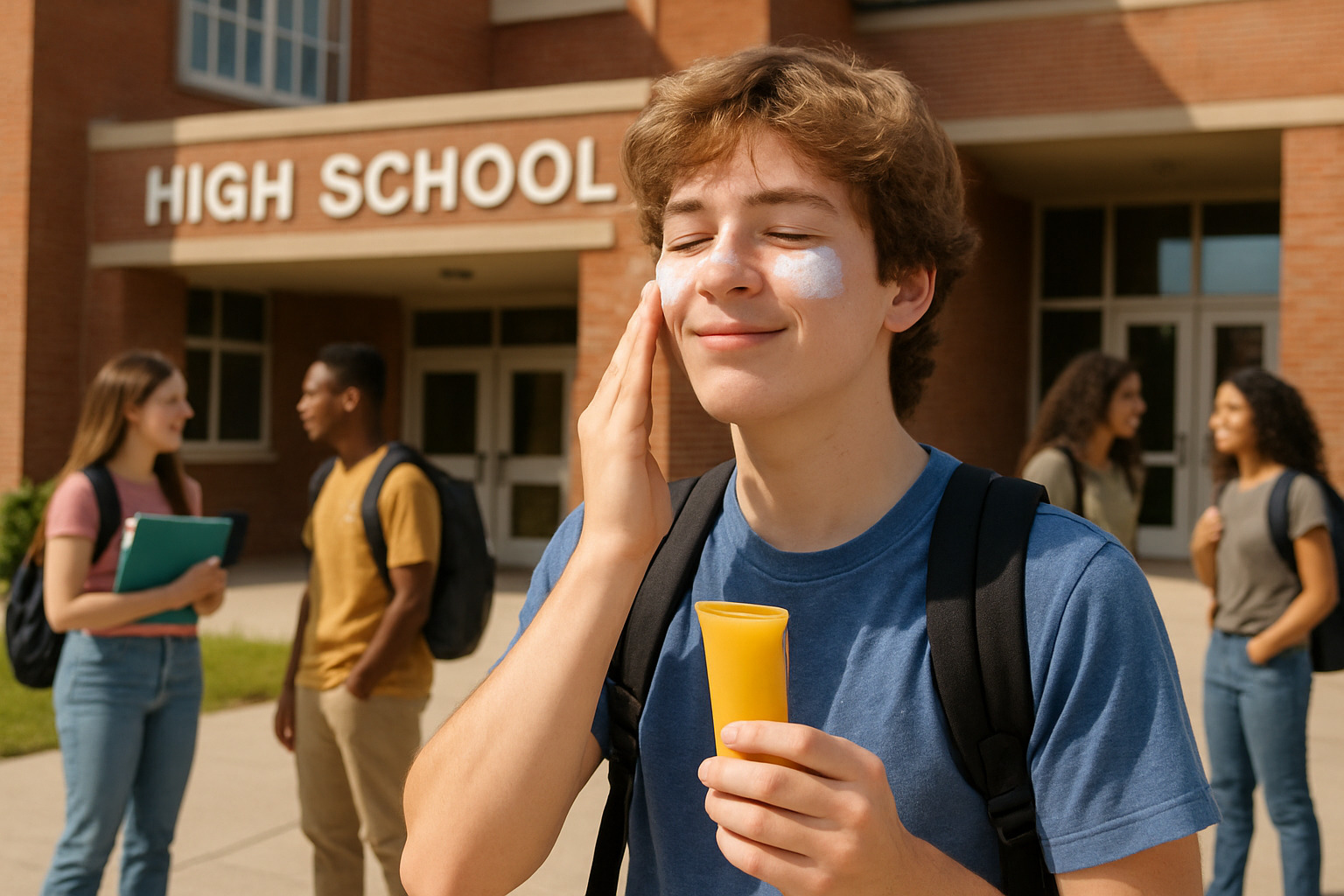
Sun protection is the best anti-aging investment you can make as a teenager. UVA rays penetrate deep, causing premature aging, while UVB rays cause sunburns and increase skin cancer risk. Both damage skin even on cloudy days, and car windows don’t fully protect you.
Using a tanning bed even once increases skin cancer risk. There’s no such thing as a “safe tan” – any color change means DNA damage is occurring.
Apply sunscreen 15-30 minutes before going outside, use SPF 30+ broad-spectrum protection, and reapply every 2 hours. Don’t forget ears, neck, feet, and lips. Peak hours are 10 AM to 4 PM – seek shade during these times.
Proper cleansing becomes important when using daily sunscreen. Check out Scientific research on face washing for effective removal techniques.
Choosing the Right SPF
SPF 30 is your sweet spot – it blocks 97% of UVB rays, while SPF 50 only blocks 98%. Dermatologists recommend lotion over spray for more even coverage. If using spray, apply generously and rub in thoroughly.
For acne-prone skin, look for “non-comedogenic” labels. Mineral sunscreens with zinc oxide or titanium dioxide are often gentler, though they may leave slight white cast initially.
For school reapplication, keep small tubes in your backpack or use powder sunscreen over makeup.
Busting Tanning Myths
That “base tan” provides roughly SPF 3 protection – basically nothing. Any tan indicates DNA damage in your skin.
For sun-kissed glow without damage, try self-tanning products or bronzing makeup. Mix self-tanners with moisturizer to avoid orange streaks, and always wash hands thoroughly after application.
Making sun protection a daily habit now is one of the best gifts you can give your future self.
Makeup, Hair & Nail Know-How

Beauty tips for teens should improve natural features rather than mask them. Your teenage skin has natural glow that doesn’t need heavy coverage. Lightweight formulas and non-comedogenic products work best for young skin.
Think of makeup as fun accessory rather than necessity. The key is learning what makes you feel confident and comfortable.
For ethical choices, explore Cruelty-Free Makeup Brands for Teens to make informed decisions.
Healthy Makeup Habits for Teens
Expiration dates matter – toss mascara every three months, foundation lasts up to a year if stored properly. Clean brushes weekly with gentle shampoo. Never share eye makeup – infections spread easily and can be serious.
The “less is more” philosophy works well during daytime. Try tinted moisturizer instead of full-coverage foundation. Remove makeup completely before bed – sleeping in makeup clogs pores and can cause eye infections.
Hair & Scalp TLC
Hair changes during puberty, often becoming oilier. Gentle shampoo works better than harsh formulas. Over-washing triggers more oil production. Most teens do well washing every other day.
Apply conditioner from mid-shaft to ends only, avoiding scalp. Heat styling damages developing hair – try heat-free methods like braiding damp hair for waves. Regular trims every 6-8 weeks prevent split ends.
Nail & Oral Quick Fixes
Clean, trimmed nails look polished without polish. File in one direction to prevent tears. If you bite nails, try bitter-tasting treatments.
For oral health, use lip balm with SPF and maintain fresh breath by brushing twice daily and staying hydrated. A confident smile is your best accessory.
Eat, Drink, Think: Inside-Out Glow
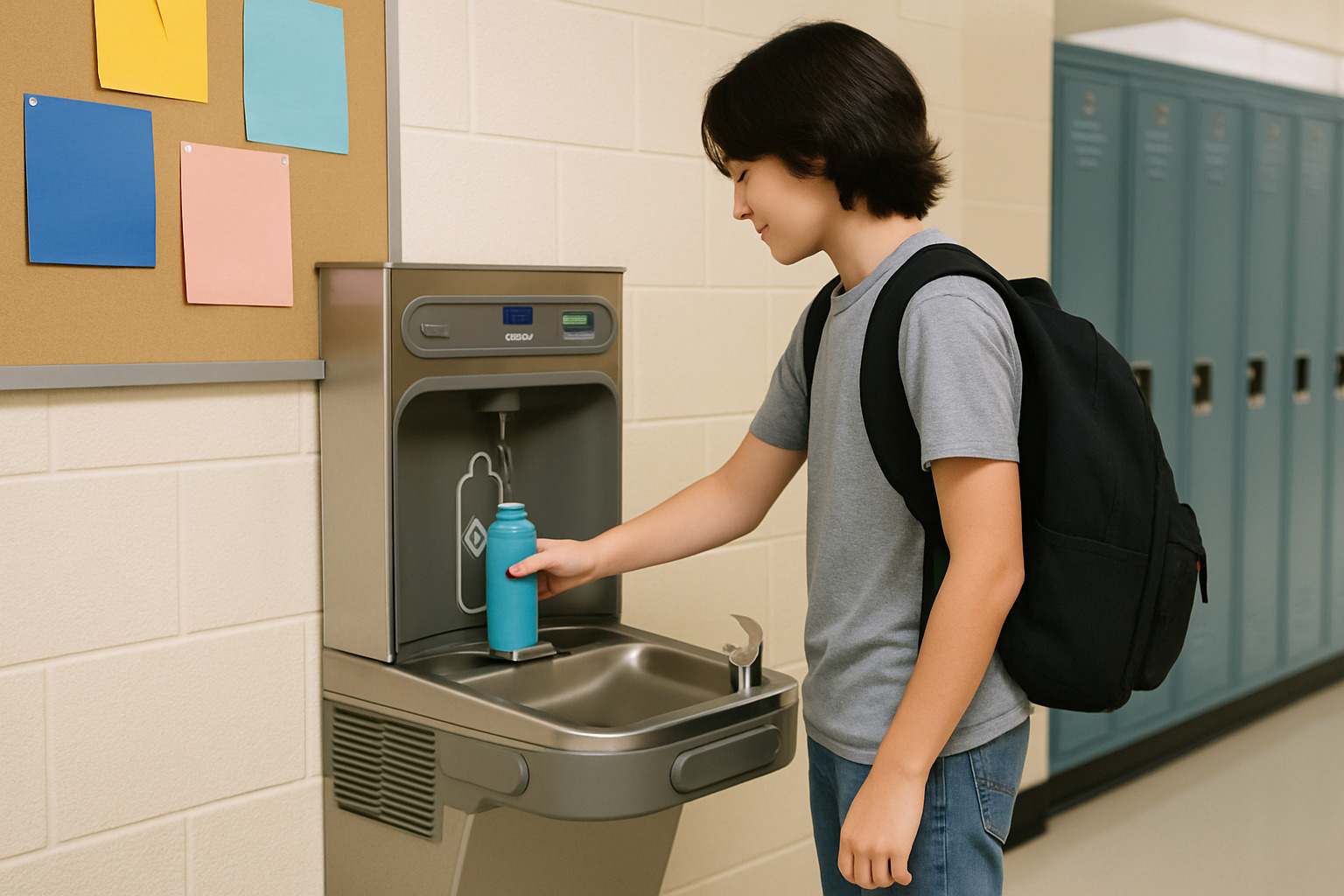
Effective beauty tips for teens start from inside out. What you put into your body shows up on your skin and confidence level. Your skin reflects what’s happening inside – stress, dehydration, or processed foods often show through breakouts or dullness.
Research suggests high glycemic index foods may worsen breakouts in some teens. Staying hydrated with 8-10 glasses of water daily makes skin look plumper and clearer.
Sleep is your secret weapon – during 7-9 hours of recommended sleep, your body repairs skin damage and produces new cells.
Complement your routine with Natural Skincare Tips for gentle, effective approaches.
Food & Mood for Clear Skin
Make whole foods your foundation. Colorful fruits and vegetables provide antioxidants that fight inflammation. Berries, leafy greens, and orange vegetables supply vitamins A and C for skin repair. Fatty fish, walnuts, and avocados deliver omega-3s that reduce inflammation.
Zinc-rich foods like pumpkin seeds and chickpeas support skin healing. Some teens find limiting dairy products helps skin stay clearer. Sugary drinks and processed snacks can trigger inflammation in some people.
Hydration goes beyond water – include water-rich foods like watermelon and cucumber. Add lemon or mint to plain water for variety.
Cultivating Confidence
Real beauty radiates from confidence. Social media can be a confidence killer with filtered, edited images. Unfollow accounts that make you feel bad and seek content promoting self-acceptance.
Practice positive self-talk – instead of “I hate my skin,” try “My skin is healing every day.” Focus on what your body can do rather than just appearance.
Exercise for 60 minutes daily can be dancing, walking, or sports. Movement boosts circulation and releases mood-improving endorphins. Talk to trusted adults when struggling with body image.
Building confidence takes practice – stand straight, make eye contact, and smile genuinely.
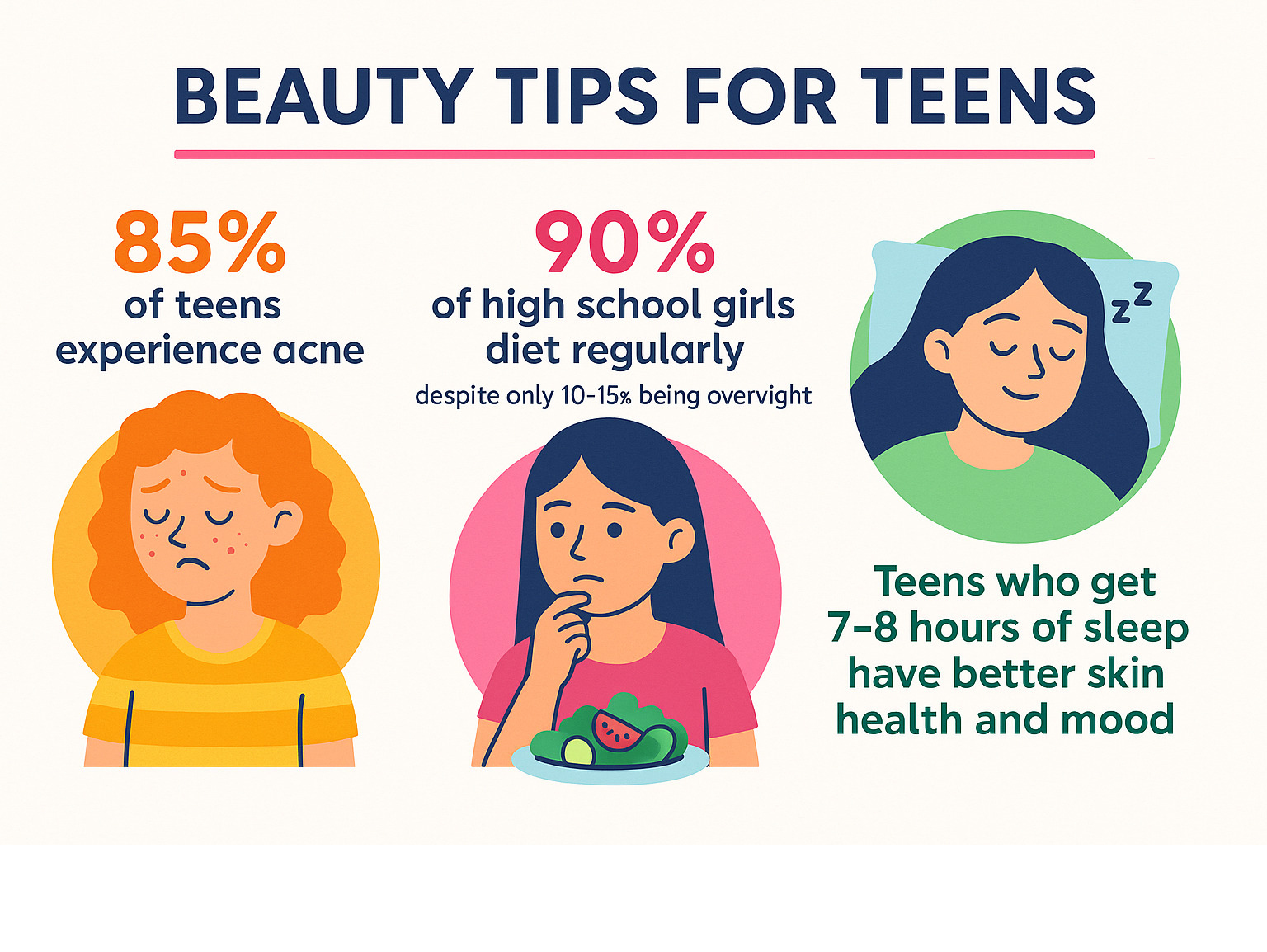
Frequently Asked Questions about Beauty Tips for Teens
Why is sunscreen important if I’m inside most of the day?
Even if you spend most of your time indoors, UV rays can sneak through windows and reach your skin. Those quick walks between classes, eating lunch outside, or sitting by a sunny window all add up to significant sun exposure over time.
Here’s what many teens don’t realize: UV damage is cumulative, meaning it builds up slowly over years and decades. The sun damage you get as a teenager will show up as wrinkles, dark spots, and potentially skin cancer when you’re older.
If you’re using acne medications like retinoids or benzoyl peroxide, your skin becomes even more sensitive to sun damage. These treatments make your skin more vulnerable to burning and long-term damage, which is why dermatologists are so insistent about daily sunscreen use.
The good news is that many moisturizers now include SPF, making daily protection super easy. Look for broad-spectrum SPF 30 or higher in your daily moisturizer – this way, you’re protecting your skin without adding extra steps to your routine.
How do I pick products for sensitive skin?
If your skin gets red, itchy, or irritated easily, you’ll want to become a label-reading detective. Look for products marked “fragrance-free,” “hypoallergenic,” and “dermatologist-tested.” These aren’t just marketing terms – they indicate that the product has been formulated with sensitive skin in mind.
Avoid these common irritants: alcohol-based toners, products with strong fragrances, and anything with harsh scrubbing particles. Your skin barrier is already compromised if it’s sensitive, so gentle is always better.
Before trying any new product, do a patch test on your inner wrist or behind your ear. Apply a small amount and wait 7-10 days to see if you develop any redness, itching, or irritation. It might seem tedious, but it’s much better than dealing with a face full of irritated skin.
For sensitive skin, simpler routines work better. A basic three-step routine of gentle cleanser, fragrance-free moisturizer, and mineral sunscreen is often more effective than complex multi-step regimens that can overwhelm delicate skin.
When should I see a dermatologist?
Many teens try to tough it out with drugstore products longer than they should. Don’t wait too long to get professional help – early intervention can prevent scarring and more serious skin issues down the road.
Schedule that dermatologist appointment if your over-the-counter acne treatments haven’t improved your skin after 6-8 weeks of consistent use. This timeframe is important because it takes at least a month for your skin to adjust to new products and show real improvement.
You should also see a professional if you’re dealing with painful, deep cysts or nodules that feel like hard bumps under your skin. These types of breakouts rarely respond to over-the-counter treatments and often require prescription medications.
Scarring is another red flag – if your acne is leaving permanent marks or deep pitted scars, professional treatment can help prevent further damage and may be able to improve existing scars.
Perhaps most importantly, if your skin condition is affecting your self-esteem or daily activities, that’s reason enough to seek help. Many dermatologists offer specific teen acne programs and truly understand the unique challenges of adolescent skin. Your mental health matters just as much as your physical skin health.
Conclusion
Your journey with beauty tips for teens is about building self-care habits that will make you feel confident and healthy for years to come. The skincare routine you start today trains you to take care of your body, be patient with changes, and make choices supporting your wellbeing.
The real secret isn’t perfect skin – it’s developing a healthy relationship with beauty itself. This means understanding your worth isn’t tied to whether you wake up with a pimple. It’s about taking care of yourself because you deserve to feel good.
At Beyond Beauty Lab, we’ve seen teens transform not just their skin, but their confidence when they focus on gentle consistency and self-acceptance. Your skin will continue changing throughout life, and having the knowledge and habits to adapt matters most.
Start simple and be patient – that basic routine of cleansing, moisturizing, and sun protection might seem easy, but consistent habits create the most dramatic improvements over time.
Your beauty routine shouldn’t add stress. Let it be a few minutes each day when you’re doing something kind for yourself, preparing you to take on whatever the day brings.
For more comprehensive wellness and clean beauty resources, explore our resource guide for additional tips and insights beyond skincare.
Your unique personality, how you treat others, and confidence from taking good care of yourself – these make you truly beautiful. The right beauty tips for teens should improve who you already are, not try to turn you into someone else entirely.

